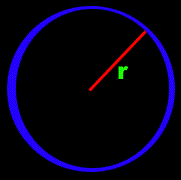

| Procedure: This first step is to measure the circumfrance and the radius of the circle. Circumfrance is the distance around the outside of the circle, (blue line) the radius |
 |
Circumferance Experiments
| Object | Circumfrance | Diameter | Experimental Value of Pi |
| Roll of Tape |
|
|
|
| Record |
|
|
|
| Experimental Ave. Value of Pi | True value of Pi | Percent Error |
| 3.04 |
|
|
| Object | Given Volume | Measured Height | Measured Radius | Exp. Value of Pi |
| Soda Can | 354.72 Cubic cm | 11.76 cm | 3.19 cm | 2.97 |
| Bottle of Whiteout | 17.74 Cubic cm | 4.45 cm | 1.15 cm | 3.01 |
| Experimental Ave. value of Pi | True Value of Pi | Percent Error |
| 2.99 |
|
|
| Scientific AmeriKen would wish to make a dedication to several contributers, Brian Kobashikawa, for assistance of musical selections, as well as some pieces of his own, Brad Hutcheson, and "Dr. John" for additional reasearch they have done on their own. Thanks! |